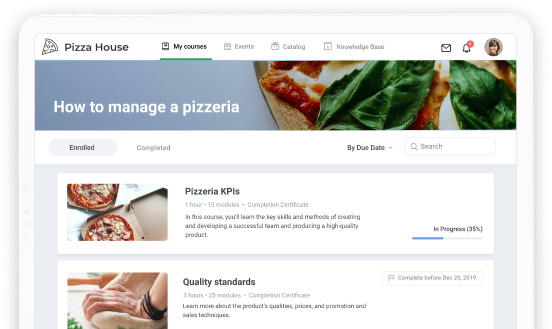Classroom or Online: Which is the Best Place to Learn?

Most adults, at some point in their lives, have gone to learn in a classroom environment, whether as part of continuing education or work-related training. In 2005, 44% of American adults were participating in some form of classroom based continuing education. That figure doesn’t even take into account the number of adults who were being educated within their organizations, rather than an educational institution. But what if we lived in a world where all education was done online?
Pros and cons to classroom learning
Let’s start with the pros:
- Exchange of ideas with other students ‘face to face’.
- Development of soft skills unrelated to the material, such as presentation skills or socialization skills.
- Direct interaction with the instructor.
Cons:
- Classroom size: too many students leads to reduced discussion.
- Accessibility: being required to be in a certain place at a certain time for a specified period of time does not work with all schedules and lifestyles.
- Cost: requiring individuals to travel to and be present at certain times and locations can be costly both in terms of the class itself and the time taken away from other duties.
- Fosters passive learning: the student may simply be taking in information without any real level of interaction (depending on number of students, etc.). Ongoing feedback and interaction facilitates learning. With no alternative method of communication, less vocal students will not have the opportunity to participate as freely and the instructor will not as easily identify students who require reinforcement of the concepts being taught.
Pros and cons to online learning
Pros:
- Accessibility to the instructor and additional resources at any time. The ability to ‘chat’ or ask questions outside of a specified class time is highly beneficial as students learn and grow.
- Allows the instructor to identify student’s needs on an individual basis and provide resources accordingly, creating a more active learning environment.
- Cost is relatively low because e-Learning authoring tools facilitate the creation of ‘lessons’ that can be changed and improved on the fly and to suit the needs of the students. Further, there are no costs related to travel or work downtime.
- Accessibility of the material: e-Learning students can access the materials when it suits them and their schedules, creating a more positive engagement.
- Instructors benefit as well, by saving time on tasks such as grading a quiz, which can be automated, and instead being able to focus on queries posed by their students or creating more resources.
Cons:
- Less direct social interaction therefore less development of soft skills unrelated to the material.
- The initial acquisition of the technology / hardware for each student to be able to engage in e-Learning. That said, since e-Learning tools can be adapted to almost any mobile technology, most adults are already equipped in some form or another, with the tools they would need.
Also read: → Online assessment in education
So which is the best place to learn: online or in a classroom?
Ultimately, at the academic levels, a mixture is probably more effective, leaning towards the classroom style. After all, students enroll in full-time academic institution programs for the express purpose of learning in group environments. Some online activity is certainly realistic and effective but probably wouldn’t make up the bulk of most of the learning opportunities.
Learning as part of career growth, however, is a different matter. Individuals who are working full-time find that e-Learning or mobile learning, as part of their daily or weekly schedules, is more effective and responsive in the long run than taking swathes of time out of their regular schedules to attend formal in-class instruction. There are times where the latter is necessary, where a more ‘hands on’ approach is required, but ultimately, the student is going to learn better if the material is timely and meets their immediate needs, rather than being forced in at a time that might not suit them.
Organizations will find e-Learning to be more effective both in terms of the participation of their employees, the results achieved and the overall costs of the programs.
Do you have any knowledge or experience to share about online and in-class learning? Share it in the comments below!
